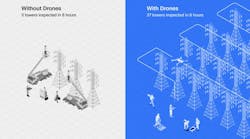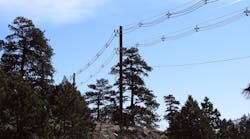- Aging infrastructure and workforce: Legacy systems are at riskof failure, and a wave of retirements is leaving gaps in critical knowledge and skills.
- Regulatory and stakeholder pressures: The need to meet compliance and the balancing act of meeting expectations from customers and investors are more demanding than ever.
- Climate threats and Security Risks: Increasing severe weather events and potential security breaches like cyber-attacks or physical threats to infrastructure require swift and effective responses.
- Digital transformation: Adopting new technologies is essential but introduces challenges in integration and operationalization.
- Maximizing productivity
Drones perform routine inspections and maintenance tasks with greater speed, efficiency, and reach than traditional methods. For instance, drone-based inspections can reduce the time spent inspecting transmission lines or substations from hours to minutes, allowing utility workers to focus on the most impactful tasks. - Enhanced data
With high-resolution imaging and real-time data capture, drones provide detailed insights into the condition of utility assets. This data is crucial for implementing predictive maintenance strategies, where maintenance is performed based on actual asset condition rather than predefined schedules. - Increasing safety
By employing drones for inspections in hazardous or hard-to-reach areas, utilities reduce the physical risks to human workers. Drones easily access high voltage lines, wind turbines, and remote substations, ensuring comprehensive monitoring without putting workers in harm’s way. - Knowledge transfer
Drones contribute to knowledge preservation by capturing detailed inspections and operational data. This information can be integrated into training modules to quickly bring new employees up to speed and to enhance the expertise of the current workforce, effectively transferring knowledge from retiring experts to incoming talent, as well as building a digital record. - Regulatory compliance
Drones simplify the process of collecting data needed to meet stringent regulatory standards, improving compliance with fewer human resources and redirecting efforts to critical maintenance and operational needs, thus multiplying the output of staff. - Environmental monitoring
Drones assess environmental risks such as vegetation encroachment or erosion efficiently over vast areas, providing frequent and thorough inspections with fewer staff, thereby enhancing the utility's ability to manage environmental challenges effectively. - Emergency response
In emergency situations, drones provide rapid, real-time assessments, allowing utilities to respond swiftly and effectively. This capability ensures that workforce efforts are concentrated where they are most needed, maximizing output during critical operations.
Real world impact
An East Coast municipality has revolutionized utility inspection workflows by introducing drones, leading to unprecedented gains in efficiency and productivity. Prior to drone integration, the utility team managed to inspect three towers per day. With drones, they have dramatically increased their capacity, inspecting 37 towers daily—a remarkable 1137% improvement in output.
The future of asset management
AI-powered docked drones are revolutionizing the utility sector by enabling smart asset monitoring and rapid incident response. This technology not only responds to emergencies like security threats or natural disasters but also proactively inspects and monitors critical infrastructure to meet regulatory mandates and stakeholder expectations.
Advantages of continuous monitoring
- Continuous proactive inspections
Drone docks stationed at critical sites allow for regular, automated inspections without human intervention. These drones can be scheduled to monitor critical infrastructure components, detecting issues before they become critical failures. This continuous monitoring capability significantly reduces the downtime and maintenance costs. - Rapid incident response
In the event of outages, weather events, or other emergencies, drones can be immediately deployed from their docks to assess and document the situation. This rapid response capability allows utilities to quickly understand the extent of damage, plan recovery operations more effectively, and restore service faster than ever before. This real-time data enables decision-makers to act quickly, minimizing the duration and impact of disruptions on customers. - Autonomous security patrols
Drone docks also enhance site security by conducting scheduled or random aerial patrols around the perimeter and critical areas. This not only helps in early detection of physical threats or breaches but also ensures comprehensive surveillance without the need for constant human presence, freeing up human security forces to focus on more strategic tasks. - Integration with central monitoring systems
This integration allows for advanced data analytics, predictive maintenance scheduling, and enhanced decision-making processes. Decision-makers have access to a wealth of actionable insights, enabling them to preempt potential issues, optimize resource allocation, and improve overall operational efficiency of the organization.
About Skydio
Skydio provides utilities with tools that transform their operations and maintenance strategies. Skydio drones are more than just tools; they are reliable partners in the utility sector's ongoing quest for efficiency and resilience.



